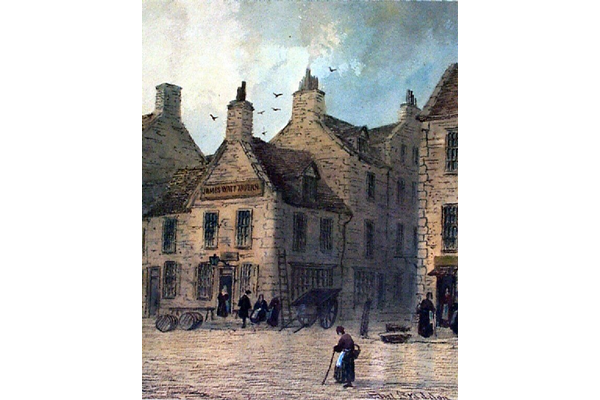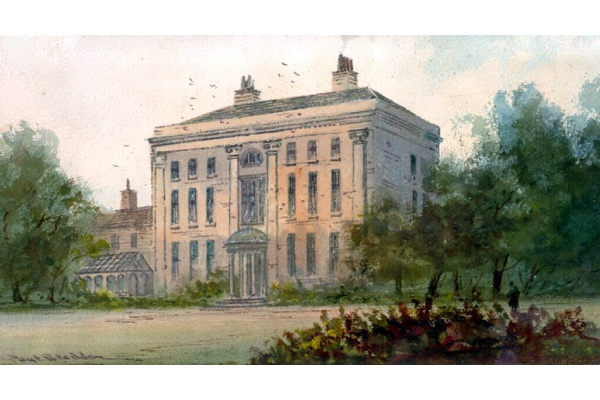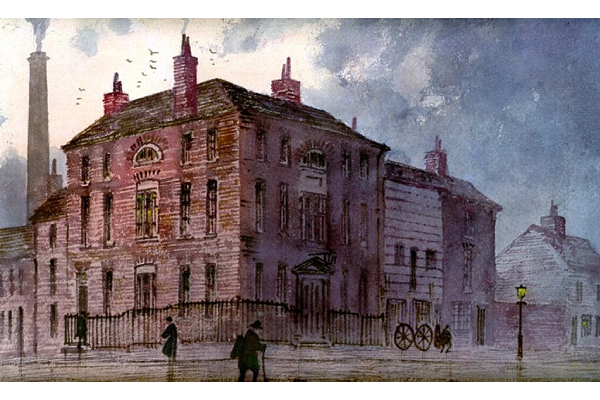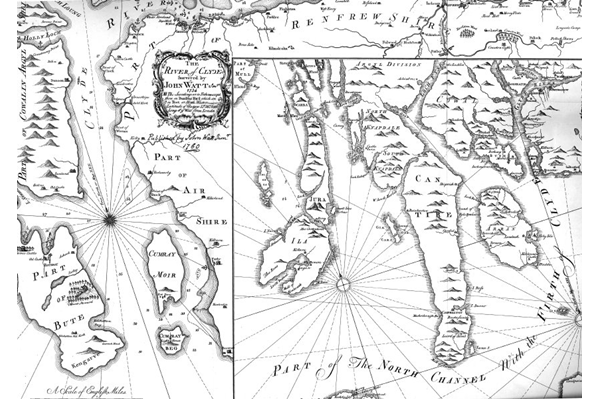James Watt (1736-1819)
James Watt is the most famous person to have been born in Inverclyde. He was born in Greenock on the 19 January 1736. When he was 18 he travelled to London to learn the skills of a scientific instrument maker and return to Glasgow to set up a business. However he was blocked by the Glasgow Guild of Hammermen for various reasons but eventually he managed to work for Glasgow University, maintaining astronomical instruments and other apparatus.
It was at Glasgow he began experimenting with steam leading to several important insights. However he lacked the capital to develop his ideas and after various false starts eventually moved to Birmingham, becoming, in 1775, a partner with Matthew Boulton, a leading industrial producer. He was to have a successful partnership with Boulton, producing steam engines and fending off the patent infringements of his rivals and transforming the industrial landscape.
Watt died on 25 August 1819 at his home in Birmingham.

James Watt (1736-1819) by John Partridge (1790-1872) after Sir William Beechey (1753-1839)
James Watt (1736-1819) by John Partridge (1790-1872) after Sir William Beechey (1753-1839) - Oil on canvas - 77 x 64 cm - 1978.365 © McLean Museum and Art Gallery, Greenock

James Watt (1736-1819)
James Watt (1736-1819) - Watercolour miniature by an unknown artist - 1978.230 © McLean Museum and Art Gallery, Greenock

Cameo of James Watt (1756-1819)
Cameo of James Watt (1756-1819) by William Wyon (1795-1851) - 1997.220 © McLean Museum and Art Gallery, Greenock

The Birthplace of James Watt, Greenock
The Birthplace of James Watt, Greenock by Paul Braddon (1864-1937) - Watercolour on paper - 41.1 x 34.1 cm - 1977.660 © McLean Museum and Art Gallery, Greenock. The work shows a conjectural view of the birthplace of James Watt at the corner of Dalrymple Street and William Street, Greenock in a later nineteenth century incarnation as the 'James Watt Tavern'.

James Watt's House, Delftfield Lane, Glasgow
James Watt's House, Delftfield Lane, Glasgow by Paul Braddon (1864-1937) - Watercolour on paper - 36.7 x 33.9 cm - 1977.668 © McLean Museum and Art Gallery, Greenock. From 1763 one of Watt's interests was in a pottery factory in Glasgow. The site of the pottery was at Delftfield Lane. The street was later renamed 'James Watt Street'.

Sarehole Mill, Moseley, Birmingham
Sarehole Mill, Moseley by Paul Braddon (1864-1937) - Watercolour on paper - 18.3 x 26.9 cm - 1977.662 © McLean Museum and Art Gallery, Greenock. Sarehole Mill was where one of Watt's partner Matthew Boulton (1728-1809) started out. In the late 1890s Sarehole was the childhood haunt of author J.R.R. Tolkien, creator of The Lord of the Rings.

Soho Works, Birmingham
Soho Works Birmingham by Paul Braddon (1864-1937) - Watercolour on paper - 28 x 48.7 cm - 1977.664 © McLean Museum and Art Gallery, Greenock. As James Boswell recalled: 'I shall never forget Mr. Boulton's expression to me, 'I sell here, sir, what all the world desires to have - power'.

Matthew Boulton's Residence, Soho Hill, Birmingham
Matthew Boulton's Residence, Soho Hill, Birmingham by Paul Braddon (1864-1937) - Watercolour on paper - 20.4 x 38.4 cm - 1977.661 © McLean Museum and Art Gallery, Greenock. This was the elegant home of the industrial pioneer Matthew Boulton from 1766 to 1809.

Clifford's Rolling Mill
Clifford's Rolling Mill by Paul Braddon (1864-1937) - Watercolour on paper - 24.6 x 34.8 cm - 1977.665 © McLean Museum and Art Gallery, Greenock.

Boulton and Watt's Showroom, Birmingham
Boulton and Watt's Showroom, Birmingham by Paul Braddon (1864-1937) - Watercolour on paper - 1977.670 © McLean Museum and Art Gallery, Greenock. The popular showrooms enabled the public inspect and order the finished products in gilt brass, cut steel, silver, plate, tortoiseshell, enamel and other materials.

Heathfield House, Handsworth, Birmingham
Heathfield House, Handsworth, Birmingham by Paul Braddon (1864-1937) - Watercolour on paper - 19.2 x 38.3 cm - 1977.666 © McLean Museum and Art Gallery, Greenock. Heathfield Hall, sometimes referred to as Heathfield House, was built between 1787-1790 for James Watt, and was designed by Samuel Wyatt. Heathfield Hall was demolished in 1927.

Harper's Hill, Birmingham
Harper's Hill, Birmingham, The Home of James Watt 1777-1792 by Paul Braddon (1864-1937) - Watercolour on paper - 46.4 x 49.3 cm - 1977.669 © McLean Museum and Art Gallery, Greenock. This house had several innovations invented and designed by James Watt.

Waggon and Horses Inn
The Waggon and Horses Inn, Holyhead Road, Handsworth, Birmingham by Paul Braddon (1864-1937) - Watercolour on paper - 26.3 x 38.2 cm - 1977.663 © McLean Museum and Art Gallery, Greenock. The Waggon and Horses Inn was where James Watt was the victim of industrial espionage when a rival overheard a conversation concerning Watt's invention of the crank.

St. Mary's Church, Handsworth
St. Mary's Church, Handsworth, Birmingham by Samuel Henry Baker (1824-1909) - Oil on canvas - 46 x 68.8 cm - 1978.366 © McLean Museum and Art Gallery, Greenock. This church contains the grave of James Watt with a memorial by Sir Francis Chantrey.

Heating System at the Hunterian Museum
Plan by James Watt (1736-1819) for the installation of a heating system in the Hunterian Museum, at that time in its former location in the Old College of the University of Glasgow. - 1808 - 1997.17 © McLean Museum and Art Gallery, Greenock.

Map of the Clyde
Map of the Clyde as surveyed by John Watt (1694-1737) in 1734 and published in 1758 by James Watt (1736-1819) and sold at his shop in the College of Glasgow in 1759. - 2003.14 © McLean Museum and Art Gallery, Greenock

James Watt's copying machine
Copying machine invented by James Watt - 1813 - 1978.386 © McLean Museum and Art Gallery, Greenock. James Watt developed his document copier between 1778 and 1780. It is said that Watt found the business of making copies of plans and correspondence very tedious and that this motivated him to create what proved to be a popular invention.

James Watt's Chemical Balance
James Watt's Chemical Balance - 1978.390 © McLean Museum and Art Gallery, Greenock. The case is made of wood and glass. The front slides out and has a drawer underneath. The scale hangs from top, balance type and has two brass pans and two silver pans.

Brace and Bit Set
Brace and Bits Set - 1815 - 1978.388 © McLean Museum and Art Gallery, Greenock. Early nineteenth century brace and set of bits presented by James Watt (1736-1819) to J. & R. Hart of Glasgow on 19 December 1815. The brace is in wood with brass trim and decoration.

Pressure Press
Late eighteenth or early nineteenth century pressure press, made in Birmingham, formerly owned by James Watt (1736-1819). The press is made of dark metal with a metal handle mounted on the side. - 1978.389 © McLean Museum and Art Gallery, Greenock.

James Watt Memorial
This memorial to James Watt stands in the Watt Library, Greenock. It was sculpted by Sir Francis Chantrey (1781-1841) in Sicilian marble. It is a replica of the statue commissioned by James Watt junior for his father's tomb in the Watt Chapel, Handsworth Parish Church. - 1978.268 © McLean Museum and Art Gallery, Greenock

Letter from James Watt 1
Letter from James Watt (1736-1819) to his Cornish agent Thomas Wilson about the Wheel Maid engine written on the 14 March 1766. - 1978.387 - © McLean Museum and Art Gallery, Greenock

Letter from James Watt 2
The letter by James Watt refers to a set of brace and bits gifted by James Watt of Robert Hart of R. & J. Hart, Glasgow. Dated 19 December 1815. - 1997.19 - © McLean Museum and Art Gallery, Greenock

Portrait of James Watt (1736-1819)
Portrait of James Watt (1736-1819) by William Nicholson (1781-1844) dated 1819 - Engraving on paper - 1997.53 - © McLean Museum and Art Gallery, Greenock

James Watt Souvenir
Piece of oak with the handwritten inscription: 'from oak beam in house in which James Watt was born in William Street, Greenock'. - 1999.61 - © McLean Museum and Art Gallery, Greenock

Parian Ware Bust of James Watt
Parian ware bust of James Watt (1736-1819). Sculpted by Edward William Wyon (1811-1885) and produced by Josiah Wedgwood & Co. in 1859. - 2001.274 - © McLean Museum and Art Gallery, Greenock

James Watt Memorial Medal
James Watt Memorial Medal in copper created for the bicentenary celebrations in 1936. - 1978.642 - © McLean Museum and Art Gallery, Greenock

Stove for the Hunterian by James Watt
Booklet description by James Watt of the 'Stove for the Hunterian.' Signed 'James Watt Heathfield Sept 5th 1808' - 1997.24 - © McLean Museum and Art Gallery, Greenock



























